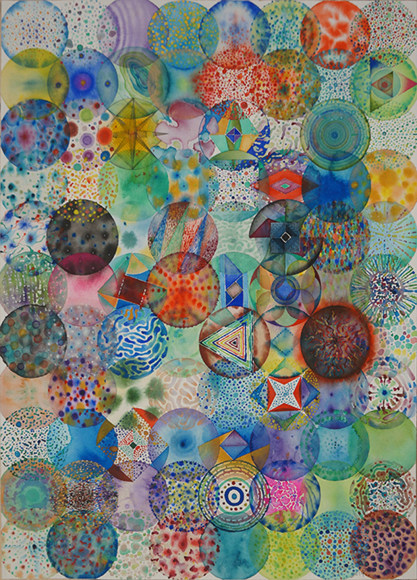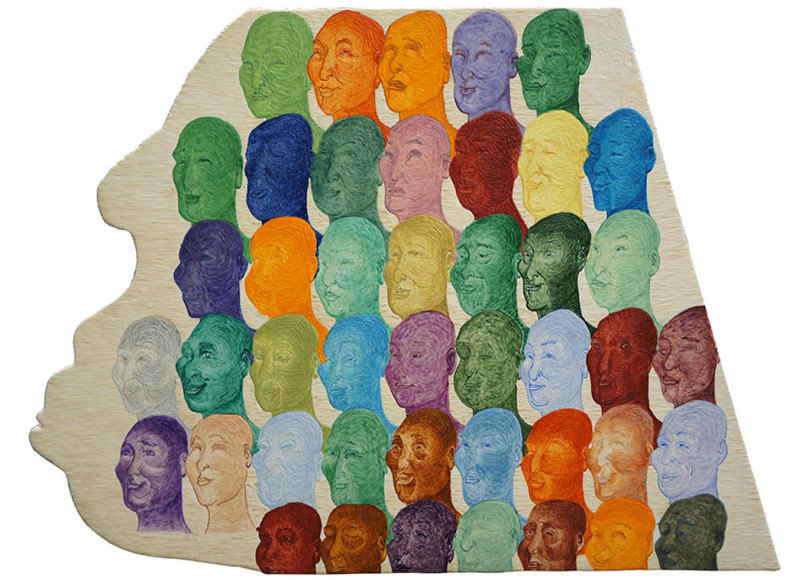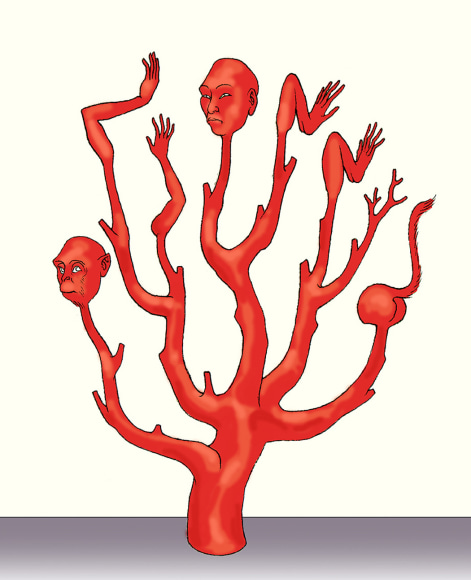Chambers Fine Art is pleased to announce the opening on November 6, 2014 of Transformation: Recent Works by Wu Jian’an. Since his first exhibition at Chambers in 2006, Wu has primarily used paper cut as his preferred medium, although he has also experimented with other materials including metal and ox hide. As his works have grown in scale, the thematic underpinnings have also become increasingly complex, deriving from a wide range of philosophical, religious and visual traditions.
The centerpiece of the current exhibition is the large encaustic painting Nirvana of the White Ape in which Wu turns to an episode in the Chinese classic text Journey to the West for inspiration. For his depiction of the white ape’s nirvana Wu turns to a stylized figurative language that reflects his deep knowledge of classical Buddhist art.
For the explosive energy generated at this moment leading to the creation of man and everything else in the universe, however, Wu turns to ritualistic acts of repetition and a visually resplendent abstraction to create an environment in which different media including painting in colored wax and water color are used to express his idiosyncratic interpretation of the legend.
The repetitive structure of 6000 Painted Faces in which each component is figurative and unique finds its abstract equivalent in Color Points I in which each color is used only once and in 792 Overlapping Colored Balls. In the spectacular abstractions as in the dizzying figurative works, Wu looks for hidden relationships between diverse forms, offering the viewer an opportunity to join him on this inward journey as he makes visual and iconographical connections between the diverse components of the installation.
Supplementing the group of works commenting on Nirvana of the White Ape is a group of recent paper-cuts, vastly more complex than his first works in this medium. Even then Wu used paper cut to express his fascination with hidden patterns of connectivity, frequently using individual elements in different combinations to reveal mysterious truths. In Faces, the new body of work dating form 2014, evocations of greatly en larged heads of creatures from the natural world emerge from multiple layers of hand-dyed and waxed paper.
As Wu Jian’an delves ever deeper into mythological and esoteric source material the scope of his ambition requires a broadening of the range of media he uses in his idiosyncratic practice. Transformation is the first impressive manifestation of this new development in his work.
自2006年他在前波画廊的首次展览之后,邬建安以剪纸作为主要媒材。《白猿涅槃》的灵感来源于中国古典小说《西游记》,邬建安尝试运用彩蜡和水彩等绘画语言为这个传奇故事作了独到的诠释。而对于本次展览中的作品《白猿涅槃》,艺术家运用了独特的风格和造型来体现出他对经典佛教艺术的深刻理解。由这件作品为起源,创作走向两条不同的发展线索:一条通过重复描绘人脸型来表现造人,而另一条则运用抽象的手段表现造物。两条线索彼此呼应,分别走向宏观的景象,就好似物质的膨胀形成了核裂变一般。
《6000张已画完的人脸》和《1000个青岛美术生画的妖精》与《苯板上的彩点》和《792个有重叠的彩色圆球》遥相呼应。前者具有重复结构然而其中每 一张脸都是独一无二;后者由成千上万个颜色组成的物理结构,色点之间界限分明,没有相交相融的地方,整体上却又呈现出一种混融的面貌。无论是在壮丽的抽象 作品还是眼花缭乱的人物作品中,邬建安试图探寻多元形态中所隐喻的神秘关系,将观者引领入他的个人创作历程,让我们亲眼目睹艺术家将本次展览的不同元素通 过想象和视觉相联系在一起的过程。而巨幅创作《72只虎组成的猴脸》使其他所有作品都显得相对较小,如此悬殊的视觉效应暗示了邬建安在艺术创作过程中的一 次奇异时空旅程。



